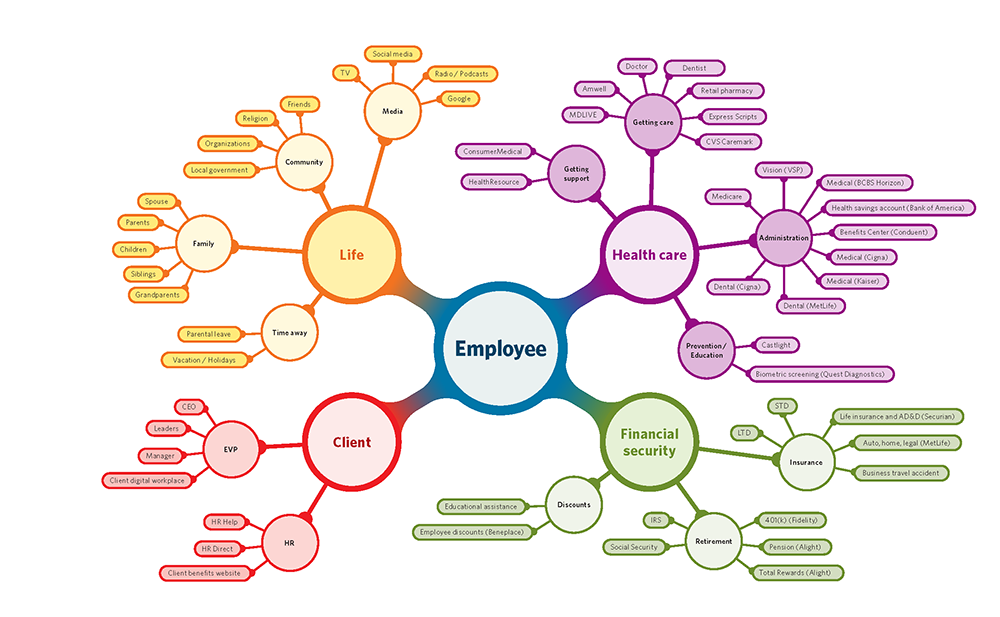
Current Trends Driving Employee Benefits Communications
Talent-focused organizations have experienced decades of challenges attracting, motivating, and retaining a highly sought-after workforce. This is driving both the benefits that organizations offer and how they are promoted. They’re also aligning those benefits with the organization’s employee value proposition (EVP) and embracing new technologies, such as generative AI in the fight for talent. Employees across generations have high expectations for ease, simplicity, and a consumer-first experience.
For example, if your business and EVP is focused on solving business problems with cutting-edge technology, your benefits and your communications strategy need to follow suit, or there will be a disconnect.
At the heart of these trends is a desire to create positive experiences for increasingly diverse employees and their families. Across our portfolio of clients, we see talent-focused organizations moving the needle by focusing on these benefits communication trends and priorities:
- Managing their communications channels
- Simplifying their benefits offerings
- Matching employees to relevant benefits
- Defining goals and tracking their results
Here’s what this means in more detail.
1. Managing Your Communications Channels
Over 20 years ago, I first heard the phrase “digital sprawl” from a colleague. Back then, many took the approach that more is always better, which led to a completely overwhelming user experience and a content management nightmare. Employees could find similar (or contradicting) information in 20 different places. Content frequently was not kept up to date and accurate, and new channels came in and out of style like the flavor of the month. Employees were confused, waved their hands, and simply said, “I don’t have the time or energy for this right now.”
That digital sprawl has not gone away, and many of our clients still struggle with how to use multiple channels effectively—SharePoint, ServiceNow, benefits websites, benefits administrator sites, decision support tools, provider websites, SPDs and compliance information, and so on. Where do employees go first? Where do they go for what information? Where do we send families? Digital sprawl is real, and if you don’t have an effective strategy and governance model, your employees will become overwhelmed, confused, and frustrated trying to navigate your benefits ecosystem.

Benefits ecosystems are more complicated than ever, and employees need good communication (and support) to help navigate. While benefits are important, they are just one piece in our complicated lives.
Addressing this problem and putting a strategy in place to help employees navigate the expanding benefits ecosystem is a key priority and trend right now. We are helping clients improve the user experience by evaluating new channels and technologies, conducting online focus groups and usability studies to listen to actual people, revising their communications channel strategy, mapping the vendor ecosystem, doing detailed channel assessments to determine strengths and opportunities for improvement, and integrating disparate platforms.
2. Simplifying Your Benefits Offerings
Most organizations have good intentions, but intentions don’t always translate to desired impact. We once had a client that offered over 20 mental health resources, and, while they were all valuable in different ways, having so many options paralyzed employees. We had another client that had 11 different places to go for telehealth, depending on need. Imagine an employee trying to figure out which telehealth service to use for their issue. It was just too much.
Over the past several years, employers have rolled out even more niche programs and point solutions to meet various needs. Many of those point solutions have expanded their offerings and capabilities in response to market demand. There can now be considerable overlap across programs and providers, even if that wasn’t the case when the program was first introduced. As described by Barry Schwartz’s Paradox of Choice, this creates confusion and dissatisfaction for employees.
As a result, we’re seeing two trends: (1) employers are consolidating programs to reduce the number of options, and (2) they’re building better tools to guide employees to the right resource at the right time, which we’ll talk about next. Consolidating programs and reducing options needs thoughtful communications, so employees understand what’s changing and why. You may have programs with low participation but very loyal users. Or you may have high utilization of a program that isn’t meeting your or your workforce’s needs. Any situation can benefit from an impact analysis that looks closely at your population and key messages that will speak to different circumstances and audiences.
3. Using Interactive Tools to Match Employees to Relevant Benefits
Quick and easy decision trees and build-your-own-adventure-style quizzes can be non-intimidating ways to help employees quickly navigate available options. Interactive quizzes have become increasingly popular for our clients, because they allow them to target relevant content in smaller chunks for their employees. They can be fun and unexpected, which keeps people looking for more.
Life events, leaves of absence, or benefits enrollment quizzes provide an easy way to walk employees through complicated information or multifaceted decisions. Interactive tools simplify the overall process and make content more accessible to employees and their families. This technique allows organizations to have a website and tools that feel personalized without requiring authentication, which is a major barrier for spousal and dependent access.
Completing a short quiz can be part of an incentive strategy to grab attention and encourage more participation. It can help motivate important behavior change. An added bonus is that the answers to any quiz, especially about employee needs and preferences, can help inform your benefits and communications strategy.
Many organizations are interested in taking interactivity to the next level and are finding ways to incorporate generative AI to improve experiences. Generative AI allows employees to use natural language to engage in conversations that will help them find information or complete tasks. We’re in the very beginning stages of the evolution of this exciting technology, and it is important to remember that it is a tool, not an answer, and you should proceed with caution.
Simplifying the complex always pays dividends.
4. Defining Goals and Tracking Results
So often when we ask the question, “What goals do you have for this campaign?” the typical response we hear is, “We just want it to look cool!” While we agree that looking good is important (it attracts and holds employees’ attention), it’s even more important to define what you’re trying to accomplish. Are you trying to make sure a specific segment of employees knows about and uses a new benefit? Or do you want to increase overall enrollment in a new program? All too often, organizations are afraid to document their goals publicly because they might not meet those goals. But, even if you don’t meet your goals, having them ensures that you use your time, energy, and resources to focus on what’s most important for your people and your organization.
We recommend defining a measurement strategy at the beginning of campaigns instead of at the end, as an afterthought. When measurement is baked in as part of the strategy, campaigns become more focused and drive more measurable (and better) results. This means asking the hard (and sometimes uncomfortable) questions early in the project and making sure you have the mechanisms in place to monitor and measure results.
- What matters most for the success of this campaign?
- What participation level will make this worth the effort?
- How will we know employees are engaging with the communications and taking the right steps?
A/B tests, user experience testing, employee listening and feedback, and data analytics are all powerful tools that should be used along the journey to better outcomes.
Find a way to measure what is important.
Embracing the Next Frontier
Some of the most important trends we’re seeing focus on innovations in technology, effectively addressing your audience’s needs, and the importance of solid strategy and measurement plans to ensure that desired outcomes are achieved. As more employers continue their battle in the war for talent, successful organizations will continue to prioritize improving the user experience, by making things easy and relevant for employees.
We’re proud to work with organizations that value their people. If you want to learn more, we’d love to talk.
Read Next
Work with Us
We partner with organizations that value their people first. Let’s talk.

Jon Stuckey, VP Creative Technology and Innovation, provides strategic vision, guidance, and solutions for our largest clients.
